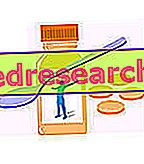Generality
The cold in newborns is a fairly common condition, which, if properly treated, turns out for the better in almost all cases.

More common from the third to fourth month of life, colds in newborns are the result of a viral infection. Among the viruses that can cause it, there are the same viruses that induce colds in adults, namely: Rhinovirus, Coronavirus, Adenovirus, influenza viruses, parainfluenza viruses, etc.
Colds in newborns are responsible for some typical symptoms, which are: runny nose, nasal congestion, fever, sneezing, coughing, loss of appetite and difficulty sleeping.
For his diagnosis, physical examination and medical history are sufficient.
Except in special cases, the cold in babies does not require the use of drugs, but only and exclusively the use of some simple home remedies, such as rest, nasal washes, periodic hydration and humidification of the air.
The cold in newborns is not a serious condition, but excessive negligence in its management can lead to complications, some of which are also very dangerous.
What is a Cold in Babies?
" Cold in newborns " is the expression that calls into question one of the most common diseases affecting the upper respiratory tract (nose and pharynx) of babies born a few months old .
Example of virus-supported infection, colds in newborns is not a particularly relevant condition from a clinical point of view; however, it does require certain care and appropriate care, as it has the potential to lead to very serious complications.
What is a cold: a brief review
One of the most common diseases in the world, the cold is a condition of viral origin, characterized by inflammation of the nasal mucosa (ie the nose) and pharyngeal (that is, of the pharynx or throat).
The cold stands out for being highly contagious and for the possibility of being transmitted both by the sick and by healthy carriers.
The cold recognizes a wide range of viruses responsible: according to the most recent research, viruses capable of inflaming the nasal and pharyngeal mucosa are more than 200 .
The Cold in Babies is Useful. Here because…
The cold in newborns is a condition that scares many parents, who would prefer their infants never to know them.
According to experts, however, the fact that newborns develop a cold is something useful, as it represents a way for those directly involved to " accustom " their bodies to certain types of infectious agents. As it happens to older individuals and adults, in fact, even the newborns, when they are victims of an infection, produce the so-called memory antibodies (ie the elements of the immune system assigned to remember the encounter with a certain infectious agent and to defend the body from a second meeting against the aforementioned agent).
The immune system - ie the set of cells, proteins, etc. which deals with protecting the organism from infectious agents and even from malfunctioning or crazed cells - it is active from birth, even if with a more limited potential compared to the years of maturity.
Causes
A cold in newborns is an example of a virus infection .
The viruses responsible for colds in newborns are numerous; such viral agents include:
- The Rhinovirus . This virus is not only the most common cause of colds in newborns, but also the most classic of causal factors in the origin of colds in adults;
- The Coronavirus ;
- The Adenovirus ;

- The Syncytial Respiratory Virus ;
- Influenza viruses ;
- Parainfluenza viruses ;
- The Metapneumovirus .
Once affected by a cold, newborns develop immunity against the responsible virus. This immunity protects against future infections due to the viral agent itself, but not from those due to similar viral agents.
In general, the immunity that newborns develop after a cold is temporary, in the sense that, after some time, it vanishes (and the subject involved becomes susceptible to the viral agent responsible for the aforementioned cold).
Who is most at risk?
The cold in newborns is more frequent after the first few months of life (generally, from III-IV), since before this time young children still enjoy the immunity that their mothers provided them (in terms of antibodies) in last months of pregnancy.
At a time when maternal immunity wears off, newborns are particularly susceptible to infections, which means they can develop several colds in the same year.
Ways of Contagion
There are many ways in which colds in babies can spread and infect healthy subjects. In detail, the list of these contagion routes includes:
- The droplets of saliva, in which the virus responsible for the condition is contained, emitted by the patient, on the occasion of sneezing or coughing ;
- Direct contact with the infected or indirect person with contaminated objects (as previously touched by the infected person). To be effectively infectious, these two ways of infection must be followed by behaviors, on the part of the healthy person, such as: touching the eyes or putting the hands in the mouth or in the nose.
Did you know that ...
Cold viruses are able to survive on the surfaces of objects even for 2-3 hours, as long as there are the right conditions.
This ability is what makes the way of contagion possible through contact with contaminated objects.
Symptoms and Complications
Colds in newborns cause a number of typical symptoms, which are:
- Runny nose (or rhinorrhea ). At the beginning of the condition, the runny nose produces a watery and light colored discharge; after a few days, instead, it is responsible for a dense and colored discharge between yellow and green;
- Nasal congestion (or stuffy nose );
- Fever ;

- Sneezing ;
- Cough ;
- Eye redness ;
- Decreased appetite ;
- Irritability marked by frequent crying ;
- Difficulty sleeping ;
- Problems with breastfeeding .
Of these symptoms and signs, those most indicative of colds in newborns are: rhinorrhea, nasal congestion and fever.
Complications
When it is in particularly severe form or when there is negligence in therapeutic management, the cold in newborns can give rise to complications, some of them even from the potential fatal outcome.
The complications in question include:
- Otitis media . It is the inflammation of the so-called middle ear. Of the possible complications of colds in newborns, it is most likely the most common;
- Breathless breathing ;
- Sinusitis . It is the inflammation of the paranasal sinuses;
- Dehydration . It is the result of very high feverish states;
- Croup (or laringotracheobronchite ). It is the disease of the respiratory system resulting from the simultaneous inflammation of the larynx, trachea and bronchi.
The croup is responsible for a barking type cough, hoarse voice and breathing problems.
- Pneumonia . It is the medical term that identifies any inflammatory process affecting the alveoli and / or the intrapulmonary section of the bronchial tree.
Characterized by difficulty breathing, profuse sweating, vomiting, high fever, cyanosis and persistent cough, pneumonia always requires specific care, especially when it concerns patients of very young age; its non-treatment, in fact, can have very severe, even lethal consequences.
When should I go to the doctor?
The phenomenon of colds in newborns is a condition to be subjected, with extreme rapidity, to the attention of the doctor, when:
- The patient has less than 3 months of life;
- The patient has more than 3 months of life and presents one or more of the following symptoms:
- He has trouble breathing;
- Presents a persistent cough or inducing gagging;
- His eyes are red;
- Fever higher than 38 ° C;
- He is frequently irritated, often cries or seems to have bad ears;
- It wets less diapers than usual;
- It has a yellow-green nasal discharge for several consecutive days;
- Produces a sputum with traces of blood;
- It's cyanotic around the lips.
Diagnosis
Typically, the diagnosis of colds in newborns is simple and immediate investigations, such as physical examination and medical history .
In other words, therefore, for the identification of colds in newborns it is sufficient to observe and accurately analyze the symptoms and signs presented by the patient.
During the diagnostic procedure for the identification of a condition such as a cold in newborns, the story of the symptoms provided by the parents of the small patient is of fundamental importance (as the latter, given his very young age, is not yet able to speak).
Therapy
If the situation is under control (ie the present infection has not resulted in complications), the treatment of colds in newborns provides only a series of simple home remedies, which serve to alleviate the symptoms and support the patient, while his immune system is providing to eliminate the virus from the body.
On the use of cold medications in newborns, the medical community is very clear and claims that the classic over-the-counter medications given to adults for cold management (eg, paracetamol, antitussives, NSAIDs, etc.) should be avoided in most children small, except in special cases and different instructions from an expert .
Important
Having a viral origin, the cold, both when it affects newborns and adults, never involves the use of antibiotics (ie drugs used to fight bacteria-borne infections).
Home remedies against colds in babies
Among the home remedies for colds in newborns, include:
- Provide for proper hydration of the patient, supplying fluids (water) periodically. In addition to preventing / combating the problem of dehydration, this remedy helps to dissolve the mucus;
- The release from the mucus of the nasal passages, through the washing of the latter with specific saline solutions;

- The maintenance of a certain degree of humidity in the room in which the small patient usually lives. A moist environment favors the dissolution of mucus and the resolution of nasal congestion;
- Rest . Avoiding all kinds of stress to young patients helps their immune system to fight the current infection more effectively.
Medications and Colds in Infants: the rules of use
Fever medications : doctors take them into consideration, when colds in newborns produce a severe fever and a serious disturbance to the patient.
Among the fever medications that find greater use in the presence of colds in newborns, include paracetamol and ibuprofen .
Important notes: paracetamol is contraindicated in patients under the age of 3 months, while ibuprofen is contraindicated in patients under the age of 6 months.
Cough medicines : the FDA (ie the US government agency for the regulation of food and pharmaceutical products) recommends avoiding them always, when the patient is a child under the age of 2 years.
Aspirin : is a drug contraindicated up to the age of 16, as in younger people it can trigger an acute condition, with a potentially lethal outcome, known as Reye's syndrome .
Prognosis
As a rule, the phenomenon of colds in newborns is resolved positively, without being associated with certain complications; therefore, in most cases the cold in newborns has a benign prognosis.
What can a Non-Benevolent Prognosis depend on?
In those rare cases in which colds in newborns give rise to complications, the reasons behind the latter are to be found in a negligence with regard to home treatments or in a particular immune fragility of the patient.
Average Healing Times
For colds healing in newborns can take up to 10-14 days .
Prevention
For parents, the main rules for preventing colds in newborns are:
- Wash baby pacifiers and toys periodically;
- Wash hands carefully before feeding the child;
- Take care to cough and sneeze into a tissue and throw it away as soon as possible (in the absence of paper tissues, the alternative is to sneeze or cough in the crook of your arm, so as to safeguard hand hygiene) ;
- Keep your child away from anyone who is sick or who may be a healthy carrier of colds in newborns (eg, the parent of a sick child).



